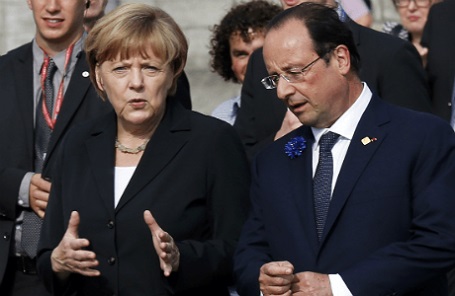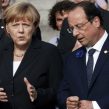
Russia, Germany Eye to Eye on Ukraine’s Border Security
Publication: Eurasia Daily Monitor Volume: 11 Issue: 125
By:

In late June and early July, German Chancellor Angela Merkel as well as Presidents Vladimir Putin of Russia, Petro Poroshenko of Ukraine and Francois Hollande of France held a series of telephone conferences in variable formats to negotiate control arrangements for the Russia–Ukraine border. Russia is massively supplying its proxy forces in Ukraine’s Donetsk and Luhansk regions across the border. Pro-Russia forces control certain sections of the border from the Ukrainian side. Ukraine is struggling to regain control of some sections, with as yet uneven results. Russia and Germany treat security arrangements on that border as contingent on Ukraine accepting a disadvantageous armistice with the secessionists.
On June 25 (during Ukraine’s unilateral ceasefire), Merkel proposed a set of arrangements in a telephone conference with Poroshenko, Putin and Hollande. Under the German proposal, Russia would accept Ukrainian border guards and OSCE observers to jointly monitor and control three sectors on the Russian side of the Russia–Ukraine border. Russia would also see to it that the Donetsk–Luhansk rebels hand over three border stations to Ukrainian border guards, from whom the secessionists had earlier captured those stations. The arrangements proposed by Merkel, however, would only be valid for the duration of the ceasefire (President.gov.ua, June 25).
Under that final codicil, Ukraine could only hope to stop Russian supplies to secessionists, if Ukraine accepted a ceasefire that would consolidate those secessionists. This linkage reflected Russia’s basic position that border control arrangements are conditional on a ceasefire and are limited to the ceasefire’s duration. This could tie Ukraine’s hands.
On June 27, the European Council’s summit in Brussels (heads of state and government of 28 EU member countries) gave Russia until June 30 to accept those arrangements; and to ensure that pro-Russia forces allow Ukrainian border guards to take back the Izvaryne, Chervonopartyzansk and Dovzhansk border stations, (European Council Conclusions, June 27). Ukraine’s unilateral ceasefire was due to expire also on June 30, although German and other Western diplomats in Kyiv were pressing for its prolongation.
On the double deadline date, June 30, Russia’s Foreign Affairs Minister Sergei Lavrov proposed to start negotiations with Ukraine about the parameters of joint supervision on the Russian side of the border. In parallel, Moscow would negotiate in the OSCE (where Russia holds veto rights) about the modalities of deploying OSCE observers at Russia’s Gukovo, Donetsk and Novoshakhtinsk border stations opposite Ukrainian territory. Those parallel negotiations would concern the numbers, mandate, equipment and other specifics of the Ukrainian and OSCE teams. OSCE’s team would be reinforced with extra Russian personnel (Interfax, June 30). Lavrov’s announcement indirectly revealed that Moscow could drag out those negotiations and leverage this process to weaken the supervision arrangements.
On July 1 and 2, however, Lavrov and his most senior deputy Grigory Karasin announced that Russia was reconsidering the whole matter. With the end of Ukraine’s unilateral ceasefire, Lavrov and Karasin recalled that the border supervision arrangements were conditional on the ceasefire being maintained and were limited to the ceasefire’s duration (in line with Merkel’s June 25 proposals above). Russia could still negotiate with Ukraine and the OSCE on the matter, but would take its time. On the same date, Russia declared those three border-crossing stations closed, although this could not be reliably verified (Interfax, July 1, 2).
The Berlin declaration of July 2 (see EDM, July 3) increased pressure on Ukraine to reinstate the ceasefire and start negotiations with secessionist leaders. On that date, Ukrainian forces had already recaptured the Dovzhansk border station from pro-Russia forces, contravening Moscow’s and Berlin’s insistence to prolong the ceasefire. The Berlin declaration reflected these developments in its own way by Russo-German consensus. It reduced from three to two the number of Russian border stations that might receive Ukrainian border guards and OSCE observers, conditional on the ceasefire being reinstated and maintained. The declaration’s key provision made Ukraine’s right to a secure border contingent on Kyiv’s position on a negotiated armistice. Rather than welcoming Ukraine’s restoration of legality at Dovzhansk, the Berlin statement simply dropped this from the list of three Ukrainian border checkpoints that Russia was supposed to persuade the secessionists to hand back to Ukraine (Auswaertiges-amt.de, July 2).
Following the Berlin conference, Lavrov restated Moscow’s position in even stronger terms. Russia would accept Ukrainian border guards and OSCE observers at those Russian border stations only after Ukraine and the pro-Russia forces had negotiated and officially announced a ceasefire. At that point, Russia would start negotiations in the OSCE’s Permanent Council about the specifics of such a mission (Interfax, July 2, 4). Pending all this, apparently, Russia may or may not allow supplies and reinforcements to secessionist forces across the border, at Russia’s discretion.
On July 3, Poroshenko told US Vice-President Joseph Biden by telephone that the proposed joint monitoring and control of the border should logically be a prerequisite to any ceasefire, not the other way around. This message could clearly be inferred from the official account of the call (President.gov.ua, July 3).
On July 6 and 8, the US State Department’s Jen Psaki criticized Russia’s triple refusal to allow Ukrainian and OSCE observers on the Russian side of the border, to stop the arms flow into Ukraine and to return secessionist-held border stations to Ukrainian government control. Citing Secretary of State John Kerry, Psaki noted that Russia does not contribute to “de-escalating” the situation and does not exert its influence on pro-Russia forces toward that goal (Unian, June 6, 8).
The United States is working with Ukraine to improve the country’s ability to control its borders. The European Union conducts its own programs to enhance border security of EU-associated countries. On June 27, Ukraine completed the signing of its Association Agreement with the EU. Bilateral Russian–German initiatives colored by Russian interests should no longer intrude into this process in Ukraine. Assisting Ukraine to secure its border should neither be contingent on Ukraine negotiating with pro-Russia forces, nor on Russia’s objectives as an active party to this conflict (see accompanying article).




